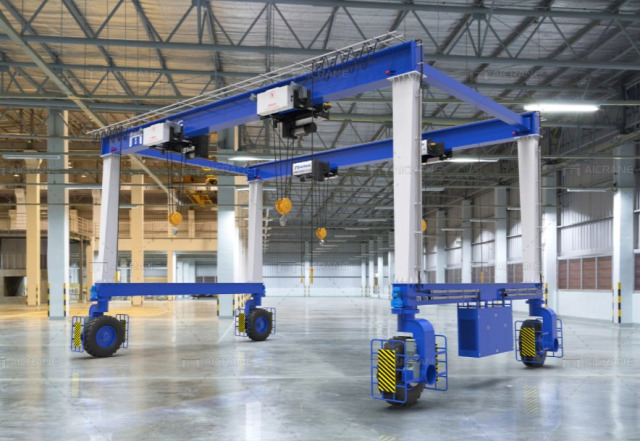Rubber-tyred gantry cranes, commonly known as rubber-tyred gantries, are versatile lifting machines widely used in various industries, including railway yards, construction sites, and manufacturing facilities. These cranes feature rubber tires, enabling them to move smoothly and efficiently on both paved and unpaved surfaces. In this article, we will explore the applications of rubber-tyred gantry cranes in three key sectors: railway yards, construction, and manufacturing, highlighting their functionality and benefits.

Rubber Tyred Gantry Crane for Railway Yards
In railway yards, rubber-tyred gantry cranes play a crucial role in handling and managing cargo containers. Here's how they are utilized:
a) Container Stacking: Rubber-tyred gantry cranes are used to stack and organize cargo containers in railway yards, maximizing storage capacity and facilitating efficient container retrieval and distribution. These cranes can lift containers vertically and horizontally, allowing for precise placement and arrangement.
b) Train Loading and Unloading: Rubber-tyred gantry cranes are employed to load and unload containers from trains, ensuring smooth and swift cargo transfer between railway cars and storage areas. The cranes' maneuverability and flexibility enable them to operate in tight spaces, efficiently transferring containers to and from the train carriages.
c) Yard Management: Rubber-tyred gantry cranes are an integral part of railway yard management systems. They enable efficient container movement, optimize yard space utilization, and contribute to the overall productivity of railway operations.
Rubber Tyre Gantry Crane for Construction
Rubber-tyred gantry cranes are also extensively used in the construction industry, where they provide significant benefits in material handling and project efficiency. Their applications include:
a) Material Transport: Rubber-tyred gantry cranes are employed to transport heavy construction materials, such as steel beams, precast concrete components, and machinery, across construction sites. These mobile gantry cranes can swiftly and safely move materials from one location to another, reducing manual labor and expediting construction processes.
b) Equipment Installation: Rubber-tyred gantry cranes are instrumental in the installation of large-scale construction equipment, such as HVAC systems, generators, and structural components. Their lifting capabilities and versatility allow for precise and controlled equipment placement, enhancing construction efficiency and ensuring proper installation.
c) Site Logistics: Rubber-tyred gantry cranes contribute to the overall logistics management on construction sites. They assist in organizing materials, optimizing storage space, and improving workflow, ultimately streamlining project timelines and reducing downtime.
Rubber Tyred Gantry Crane for Manufacturing
In manufacturing facilities, rubber-tyred gantry cranes provide essential support in material handling and warehouse operations. Their applications include:
a) Raw Material Handling: Rubber-tyred gantry cranes efficiently handle and transport raw materials, such as steel coils, wooden pallets, and containers, within manufacturing facilities. Their mobility and lifting capacity enable seamless movement between production areas, ensuring a continuous and streamlined manufacturing process.
b) Finished Goods Storage: Rubber-tyred gantry cranes are utilized for storing and organizing finished goods in warehouses or distribution centers. They enable efficient stacking and retrieval of products, optimizing storage space and facilitating prompt order fulfillment.
c) Production Line Support: Rubber-tyred gantry cranes play a vital role in supporting production lines by supplying materials, components, and machinery at the required times. Their agility and maneuverability enable them to swiftly transport items to different production areas, enhancing overall productivity and minimizing production delays.
Conclusion
Rubber-tyred gantry cranes are versatile lifting machines that find extensive applications in railway yards, construction sites, and manufacturing facilities. Whether it is handling cargo containers in railway operations, expediting material handling in construction projects, or optimizing warehouse operations in manufacturing, these cranes provide significant benefits in terms of efficiency, productivity, and logistics management. Their mobility, lifting capacity, and adaptability make them an indispensable asset in various industries, contributing to streamlined operations and improved overall performance.

